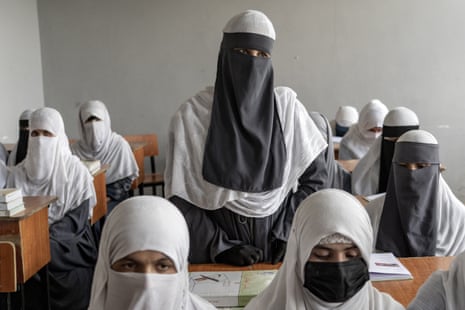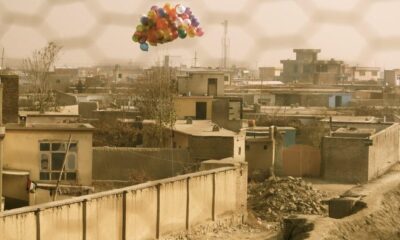World
Taliban Restructures Afghan Education, Mandates Religious Schools for Girls

The Taliban’s return to power in Afghanistan has drastically altered the educational landscape for women and girls. Since their takeover in August 2021, many have been forced into religious schooling, with reports revealing that the regime is systematically limiting educational options to religious studies.
Nahid, a 24-year-old woman from the western city of Herat, is one of the many affected. Once pursuing an economics degree with aspirations of a university career, she now spends her mornings at a madrasa. There, she recites scripture alongside 50 other women and girls, all clad in black. Nahid explains her choice to attend these classes, stating, “It’s the only way I can leave my home and fight depression.” She receives a monthly stipend of 1,000 Afghanis (approximately £11), which further incentivizes her attendance.
An investigation conducted by The Guardian and Zan Times across eight of Afghanistan’s 34 provinces has highlighted the Taliban’s strategic efforts to funnel girls into religious education. Following the regime’s decision to exclude women from secondary education over four years ago, a network of madrasas has rapidly expanded. Reports indicate that by the end of 2022, there were more than 21,000 madrasas nationwide. Between September 2024 and February 2025, nearly 50 new madrasas were either built or had foundations laid across 11 provinces.
These madrasas are predominantly operated by mullahs, who receive salaries from the education ministry. To staff the schools, the ministry has issued teaching certificates to 21,300 former madrasa students, allowing them to teach at various educational levels. Families, facing limited options since the exclusion of girls from secondary education, find themselves compelled to enroll their daughters in these religious institutions. The mullahs benefit as well; higher student numbers translate to increased salaries.
Testimonies from parents illustrate the pressure exerted by local mullahs. Karima, from Nimroz province, shared that she withdrew her daughters from secular education at the request of a local mullah who promised food aid in exchange. “But in the end, nothing came,” she lamented. Another mother, Nasreen, described being told, “Send your daughters to our religious classes or you get nothing.” Such coercive tactics appear to be reshaping community norms, prompting families to comply to avoid isolation and hunger.
In schools that remain open, the impact of this shift is evident. Many classrooms now host significantly fewer students. One teacher in Nimroz reported that 57 of her pupils had left for madrasas this year, leading to a reduction in class sizes from 40 students per grade to between 20 and 25. Even those who continue attending secular schools often split their time between madrasas and formal education, eventually succumbing to the pressure to abandon non-religious studies.
The teaching staff in these madrasas frequently lacks formal qualifications. Experienced teachers with university degrees have been dismissed, replaced by untrained former madrasa students. A headteacher in Farah province recounted being ordered to fire qualified teachers and noted that one of their replacements could not read fluently. The curriculum in madrasas is narrow, focusing on memorizing the Qur’an and the Taliban’s interpretations of Islamic law, while subjects such as mathematics and science are excluded.
Reports suggest that even international aid is being diverted to support madrasas. In one case, stationery donated by Unicef for a public school was reportedly redirected to a madrasa, with the school janitor instructed to record the supplies as “misplaced.” The burgeoning network of madrasas is reshaping Afghanistan’s job market as well. Civil servants with years of experience are being replaced by young madrasa graduates. An activist recalled that a highly qualified woman with a bachelor’s degree and two decades of experience in the women’s affairs department was dismissed without explanation, her position filled by a 17-year-old madrasa graduate.
The prevailing sentiment among young women is shifting. Many now view madrasa certificates as the safest and only viable qualification for employment. Nahid’s experience underscores this tragic irony. While her madrasa classes provide a brief respite from isolation, they are also a reminder of an ideology she does not embrace. “If I stay home, I will lose my mind,” she reflects. “If I go, at least I see other women.”
This transformation in Afghanistan’s educational system reflects broader societal changes, revealing the Taliban’s impact on women’s rights and the future of education in the country.
-

 Entertainment3 months ago
Entertainment3 months agoAnn Ming Reflects on ITV’s ‘I Fought the Law’ Drama
-

 Entertainment4 months ago
Entertainment4 months agoKate Garraway Sells £2 Million Home Amid Financial Struggles
-

 Health3 months ago
Health3 months agoKatie Price Faces New Health Concerns After Cancer Symptoms Resurface
-

 Entertainment3 months ago
Entertainment3 months agoCoronation Street’s Carl Webster Faces Trouble with New Affairs
-

 Entertainment3 months ago
Entertainment3 months agoWhere is Tinder Swindler Simon Leviev? Latest Updates Revealed
-

 Entertainment4 months ago
Entertainment4 months agoMarkiplier Addresses AI Controversy During Livestream Response
-

 World2 weeks ago
World2 weeks agoBailey Announces Heartbreaking Split from Rebecca After Reunion
-

 Science1 month ago
Science1 month agoBrian Cox Addresses Claims of Alien Probe in 3I/ATLAS Discovery
-

 Health4 months ago
Health4 months agoCarol Vorderman Reflects on Health Scare and Family Support
-

 Entertainment2 weeks ago
Entertainment2 weeks agoCoronation Street Fans React as Todd Faces Heartbreaking Choice
-

 Entertainment4 months ago
Entertainment4 months agoKim Cattrall Posts Cryptic Message After HBO’s Sequel Cancellation
-

 Entertainment3 months ago
Entertainment3 months agoOlivia Attwood Opens Up About Fallout with Former Best Friend





















